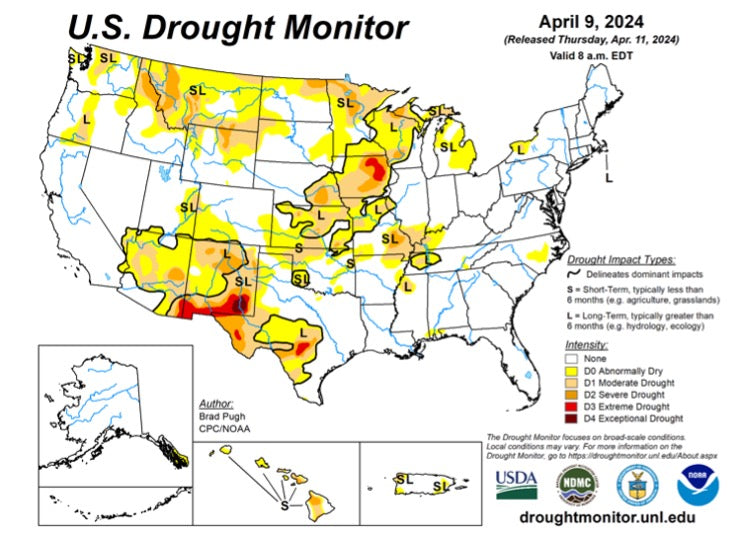Wildfire Season 2024- Predicting, Preparing, Surviving

Year-round wildfires have become the norm for many of us, but California and the West's wildfire season begins in the summer.
Midland's Meteorologist, Bruce Jones takes a look at what to expect from the 2024 wildfire season.
ABOUT WILDFIRES
Before it had humans, Earth had wildfires, ignited by the millions of lightning bolts that strike our planet every day.
In the modern world those naturally occurring sparks still start fires, but more than 70% of today’s wildfires are caused by humans. Campfires and debris fires are the most common culprit, with vehicles and power lines also big contributors. Slightly more than 10% of wildfires are arson.
WILDFIRES BECOME DANGEROUS
Sadly, what makes wildfires worse is a lush, beautiful spring. Abundant spring rain allows plants to grow greener and bigger…and to spread.
When summer comes and lush vegetation dries out, it creates a “fuel load” that allows fires to burn bigger, hotter, and faster.
On windy days, firefighters may stop fighting wind-whipped blazes to spend their time on the more important task of evacuating neighborhoods before the inferno arrives.
Greener growing seasons create more fuel and bigger fuel loads create more dangerous fires.
LOOKING AHEAD AT FIRE SEASON
Imagine if we could predict fire weather and have an idea of which areas have the best chance to burn. Then, we could alert people in those areas to fire-proof their home through changes in landscaping, and by creating barriers to keep glowing embers from igniting roofs and attics. Perhaps families could create safety plans and emergency go kits to aid in prompt evacuation. Well, we can do just that.
A fire season is made of fuel and weather. Through the cooperation of government agencies like the Forest Service, Department of Agriculture, and National Weather Service we can monitor current conditions such as drought, and comparing current dryness with long range weather forecasts, we can predict where wildfire risk will be highest up to 120 days out.

US Drought Monitor. Graphic: USDA
Wildfire forecast with a four-month lead time. Graphic: NIFC-Boise
Once a seasonal fire prediction has been made, it’s up to residents in that area to move toward preparedness.
Human nature is to bury one’s head in the sand with a “can’t happen to me” attitude, but increasingly, fire survivors are the ones who had a plan, had multiple ways to receive wildfire warnings, and got out early. Public Alert-certified radios, like the Midland WR120 are a reliable way to be alerted to Wildfire Warnings, Shelter-in-Place alerts, and Civil Emergency Messages. If you live in rural areas, a WR120 should be in every home.
FORECASTS
On critical fire weather days when strong winds and low humidity create conditions favoring rapid fire spread, the National Weather Service issues Red Flag Warnings. During these warnings citizens are urged to curtail outside burning that could potentially get out of control.
Meanwhile, from space, GOES-16 and GOES-17 weather satellites peer down to monitor for fire “hot spots”, alerting authorities to fires that could otherwise burn in remote areas for hours before being reported.

GOES weather satellites see wildfire “hot spots” (red) indicating ongoing wildfires. NASA picture
THE DANGER OF FIRES
2024’s Texas Panhandle fires burned more than one million acres, which represents about half of what would burn nationwide in a typical year.
Increasingly, big infernos fed by strong winds are creating fire nightmares with tragic consequences. The 2018 fire in Paradise, California killed 85, and the 101 deaths of the 2023 Maui fire, the largest wildfire death toll in 100 years, are stark reminders of how these violent and rapid fires can race through bone-dry trees and grasses.
IS YOUR HOME AT RISK?
On the periphery of every American city and town is an area known as the Wildland Urban Interface or WUI. This is where streets with houses give way to grasslands and forests. As our population grows, our cities grow. Today’s homes are extending into areas that previously were left empty and undeveloped….because we knew they burned. Look around your neighborhood.
Are you in an area abutting or surrounded by a large fuel load? Could a wind-whipped fire threaten your home? Keep trees, shrubs, and ornamental grasses away from the house. Remove highly flammable species like pine and eucalyptus, and make sure eaves and vents are ember-proof.
What surrounds your home will have a big effect on whether it survives.

A house surrounded by fuel. Photo: CalFire
GET PREPARED
Predictions and warnings are information, but everyone who lives in a fire-prone area needs preparation in the form of an emergency “go kit” with supplies to grab and take along during a rapid evacuation.
MIDLAND ER40 EMERGENCY CRANK RADIO
An emergency hand crank radio like the Midland ER40 is small and compact to fit easily into your bag.
Featuring AM, FM, Weather Alert, and a bright LED flashlight, this radio will keep you updated at home and on the road.
The hand crank allows you to recharge it for continual use as you navigate power outages and evacuations.
We can make predictions and issue warnings for wildfires, but in the end your survival is mostly up to you. As the head of your household, take steps now to make sure you and your loved ones are fire survivors and not victims.





